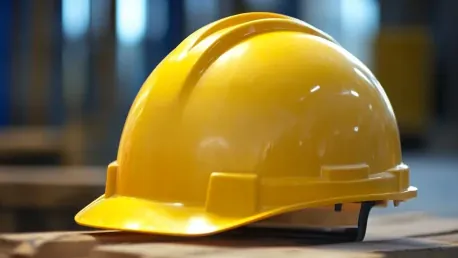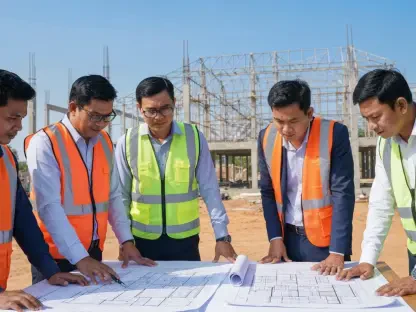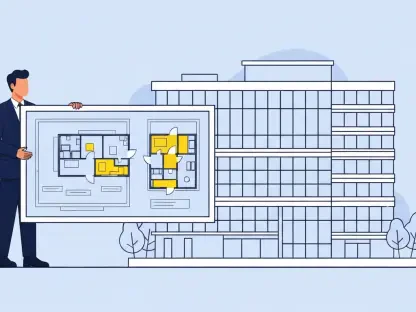In 2024, the construction industry is poised to witness a monumental shift in safety standards, driven by groundbreaking technological advancements. From wearable technology to artificial intelligence and machine learning, these innovations promise to redefine how worker safety and overall project management are approached. The following sections delve into the various technologies that are set to transform construction safety in the upcoming year.
Wearable Technology Revolutionizing Safety
Wearable technology is not just a futuristic concept; it’s here and making a significant impact on construction safety. Innovations such as smart helmets, vests, and glasses outfitted with sensors and communication devices have become an industry staple. These devices monitor workers’ vital signs in real time, detect hazardous conditions, and communicate safety alerts instantly, ensuring a proactive approach to workplace safety.
For instance, smart helmets equipped with fatigue detection algorithms can prompt workers to take breaks before exhaustion leads to accidents. Proximity sensors in wearable devices offer protection against collisions with heavy machinery, ensuring workers maintain a safe distance. Advanced functionalities in these wearables, such as GPS tracking, are crucial for monitoring lone workers, ensuring that those in isolated environments have a constant safety net. These tech wearables not only enhance safety but also boost efficiency by promptly addressing potential risks and minimizing downtime.
Furthermore, wearable technology is proving invaluable in managing environmental hazards. Smart vests can detect harmful gases or extreme temperatures, providing real-time alerts to mitigate exposure risks. Integrated biometrics in wearables offer health monitoring capabilities, enabling on-site medical interventions when necessary. This blend of proactive and reactive safety strategies marks wearables as indispensable tools in modern construction.
The Pivotal Role of Drones
Drones are revolutionizing construction site monitoring and safety management, offering capabilities that extend beyond traditional methods. With their aerial survey abilities, drones provide comprehensive site inspections, progress monitoring, and hazard identification in areas that are challenging to access on foot. High-resolution cameras and thermal imaging on drones offer a unique bird’s-eye view, highlighting safety issues that might be missed from the ground.
Drones excel in inspecting tall structures, reducing the need for physical access to potentially dangerous areas. This minimizes the risk of falls or structural failures during inspections. Additionally, drones play a critical role in emergency response situations, offering rapid damage assessments and identifying safe pathways for workers and first responders. Their ability to provide real-time situational awareness during crises makes them invaluable in enhancing site safety and coordination.
Moreover, drones contribute to data collection and analysis, feeding into larger safety protocols. They can monitor site compliance with safety regulations, document incidents, and deliver insights for future risk mitigation. By integrating drones with other technologies such as AI, construction firms can leverage a holistic safety management system that preemptively addresses hazards. This integration of advanced aerial surveillance underscores the transformative impact of drones in fostering safer construction environments.
Artificial Intelligence and Machine Learning
Artificial Intelligence (AI) and machine learning are at the forefront of predictive safety analyses in construction, offering capabilities that significantly enhance safety management practices. By analyzing vast amounts of data, these technologies can identify risk patterns and predict equipment failures before they occur. This proactive approach ensures that potential issues are addressed before they escalate into serious incidents, thereby enhancing overall site safety.
AI systems constantly monitor site conditions, worker behaviors, and equipment performance, refining their predictions and recommendations with each project. These systems learn from historical accident records, pinpointing specific risk factors and offering targeted preventive measures. By optimizing work schedules to mitigate fatigue-related incidents, AI and machine learning not only contribute to a safer working environment but also improve operational efficiency. Their continuous learning capability means that each construction project becomes safer than the last.
Furthermore, AI-driven solutions facilitate real-time decision-making by providing actionable insights. Supervisors can receive immediate alerts about unsafe conditions, enabling prompt interventions. AI can also assist in training programs, simulating potential risk scenarios and evaluating worker readiness. This integration of AI and machine learning fosters a culture of safety awareness and preparedness, ensuring that safety protocols are dynamically updated based on real-world data and simulations.
Augmented Reality (AR) and Virtual Reality (VR) in Safety Training
Augmented Reality (AR) and Virtual Reality (VR) technologies are redefining safety training in the construction industry, offering immersive learning experiences that significantly reduce real-world risks. These technologies provide workers with the ability to experience and interact with dangerous scenarios in a controlled, virtual environment. This hands-on approach to training allows workers to practice handling complex tasks and reacting to emergencies without facing actual dangers, thereby reducing on-the-job accidents due to inexperience.
On operational sites, AR-enabled smart glasses deliver real-time information about potential hazards and safety protocols. These glasses can overlay digital data onto physical environments, aiding workers in identifying hidden risks such as concealed electrical wiring or gas lines. This real-time support ensures that workers are constantly aware of their surroundings, reinforcing safety protocols through continuous feedback. The integration of AR into daily operations enhances situational awareness, making it easier to navigate and mitigate risks on-site.
Additionally, VR technology is being used to create detailed simulations of construction environments, allowing workers to familiarize themselves with site layouts and emergency procedures. These simulations can replicate extreme conditions such as fires or structural collapses, providing valuable experience in a risk-free setting. By combining training in both virtual and physical spaces, AR and VR ensure that workers are well-prepared and informed, ultimately leading to a safer working environment.
Enhancing Physical Capabilities with Exoskeletons
Exoskeletons are wearable devices that support and amplify workers’ physical capabilities, significantly enhancing safety and productivity in construction. By mitigating the risk of musculoskeletal disorders and reducing physical strain during demanding tasks, exoskeletons are transformative. These devices assist workers in lifting and carrying heavy materials, maintaining endurance for prolonged standing or overhead work, and preventing repetitive stress injuries.
The implementation of exoskeletons on construction sites promises to reduce injury rates and improve the overall health and longevity of the workforce. By augmenting different body parts, exoskeletons enable workers to perform tasks that would otherwise be physically prohibitive, ensuring that jobs are completed more safely and efficiently. This technology also opens up opportunities for older or less physically able workers to participate in labor-intensive roles, promoting a more inclusive workforce.
Moreover, exoskeletons are being integrated with smart technologies to provide real-time feedback on posture and movement, further enhancing safety. Sensors embedded in these devices can alert users to improper lifting techniques or hazardous movements, allowing for immediate corrections. This continuous monitoring and adjustment process ensures that workers operate within safe parameters, minimizing the risk of injury. The adoption of exoskeletons represents a significant advancement in occupational health and safety, contributing to a safer and more productive work environment.
Robotics and Automation: The New Frontier
Robotics and automation are transforming high-risk, repetitive construction tasks, radically reducing human exposure to potential dangers. Automated tasks such as bricklaying, welding, remote-controlled demolition, and material transportation are increasing safety and efficiency on construction sites. By taking over hazardous activities, robots minimize the risk of accidents caused by human error or physical strain, ensuring a safer workplace.
Robotics also plays a crucial role in high-risk tasks like electrical work and asbestos removal. These activities require adherence to stringent safety standards, and robotic systems can perform them with precision and minimal human involvement. This reduces workers’ exposure to life-threatening situations and hazardous materials, ensuring compliance with safety regulations while maintaining productivity. Autonomous vehicles further enhance worker safety by operating in unstable or contaminated environments, taking on tasks that would otherwise pose significant risks.
Furthermore, the integration of robotics with advanced sensors and AI allows for real-time monitoring and control, ensuring optimal performance and safety. These systems can detect anomalies, adapt to changing conditions, and make informed decisions to mitigate risks. The use of robotics and automation in construction is not only a leap towards greater safety but also a step towards a more efficient and technologically advanced industry. By embracing these innovations, construction firms can ensure safer working conditions and set new benchmarks for operational excellence.
Building Information Modeling (BIM) for Safety Planning
Building Information Modeling (BIM) is instrumental in addressing construction safety before hazards materialize on-site. By creating detailed 3D models of construction projects, BIM helps identify and mitigate safety risks early in the planning stages. These models allow for the visualization of potential hazards, enabling stakeholders to plan and implement effective safety measures before construction begins.
BIM also facilitates simulations of construction processes, optimizing safety protocols and enabling real-time collaboration among stakeholders to address safety concerns promptly. This collaborative approach ensures that all parties are informed and aligned on safety procedures, contributing to a cohesive safety strategy. Continuous updates to the BIM model keep all parties informed with the latest safety information, maintaining a safe work environment throughout the project lifecycle.
Moreover, BIM’s role extends to crafting comprehensive safety plans, including the strategic placement of safety equipment, emergency exits, and first aid stations. This proactive planning ensures that safety measures are integrated into the construction process from the outset, rather than being added as afterthoughts. By leveraging BIM technology, construction firms can create safer and more efficient work environments, ensuring that safety is a fundamental aspect of project management.
Internet of Things (IoT) Creating Smart Construction Sites
The Internet of Things (IoT) is revolutionizing construction sites by connecting smart devices and sensors to create a network that significantly enhances safety. IoT-enabled equipment can monitor conditions in real-time, identify hazardous environments, and communicate safety alerts instantaneously. This interconnected network ensures that potential risks are detected and addressed promptly, minimizing the likelihood of accidents.
For example, IoT machinery can automatically shut down when a worker enters a dangerous zone, preventing accidents before they occur. Environmental sensors can detect hazardous conditions such as gas leaks or extreme temperatures, alerting workers and supervisors to take immediate action. Wearable devices equipped with IoT technology can monitor workers’ health and safety, sending real-time data to supervisors for instant analysis and intervention.
Furthermore, IoT technology facilitates predictive maintenance of equipment, ensuring that machinery is in optimal working condition and reducing the risk of mechanical failures. This proactive approach to equipment management enhances overall site safety and operational efficiency. By integrating IoT into construction sites, firms can create smarter, safer working environments that are responsive to dynamic conditions and capable of preventing accidents before they happen.
Conclusion
In 2024, the construction industry is expected to witness a significant transformation in safety standards, driven by revolutionary technological advancements. These innovations, ranging from wearable technology to artificial intelligence and machine learning, are set to change how worker safety and overall project management are handled. Wearable technologies like smart helmets and vests embedded with sensors will monitor workers’ vital signs, detect potential hazards, and provide real-time feedback to keep them safe on site. These devices can alert workers and supervisors to conditions like extreme temperatures, fatigue, or unsafe areas, ensuring timely interventions.
Artificial Intelligence (AI) and machine learning (ML) are also making their mark by optimizing project workflows and improving safety protocols. AI algorithms can predict potential accidents by analyzing data from past incidents, while ML models can identify inefficiencies and suggest safer methods for completing tasks. Additionally, drone technology will play a crucial role in site inspections, offering a bird’s-eye view and identifying risks that might be missed from the ground.
These technologies offer a glimpse into a future where construction sites are not only more efficient but also significantly safer. Collectively, they promise to usher in a new era of enhanced safety measures and streamlined project management, ensuring that construction sites in 2024 are as advanced as they are secure.









